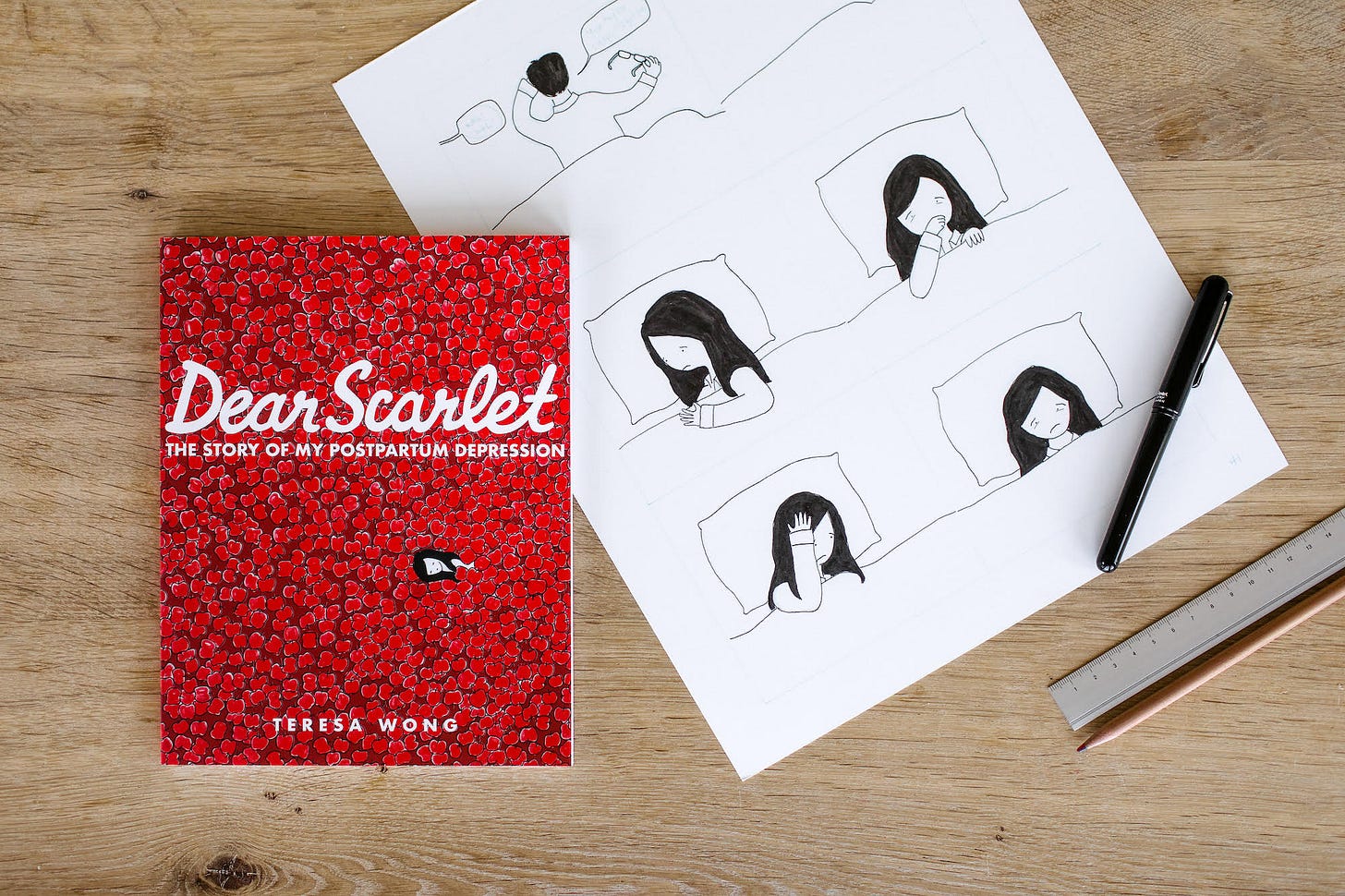Interview with Teresa Wong
I had the pleasure of meeting Teresa in a virtual comics workshop with Jeremy Onsmith at the School of the Art Institute of Chicago. Afterward, Nora and I read her graphic memoir, Dear Scarlet: The Story of My Postpartum Depression, a lovely epistolary comic that pulls no punches when confronting the reality of enduring depression. We’re happy to have had the chance to ask her some questions about her journey into comics and connecting with comics community. - Amaris
Describe your comics journey—how did you get into making comics?
I read a lot of comics as a kid, mostly stuff like Garfield, Peanuts and Betty & Veronica, but didn’t really encounter “grown-up” graphic narratives until the early 2000s, when I picked up Persepolis at an airport bookstore during a work trip and read the entire thing on my flight home. I just loved how Marjane Satrapi told such a poignant and intimate story through comics, and the book really changed my perception of what a comic could be. Once I saw what image and text could do together, the kinds of stories that you could tell, I was hooked.
When I decided in 2015 to write a book about my first postpartum experience, I knew immediately that I wanted to do it as a graphic narrative. So many of my memories were in image form, and I really wanted to capture them on paper. I also remembered the excruciating silence of being a new mother at home with a tiny baby, and I felt a graphic narrative would be the best way to convey that quiet time.
However, I was a writer, not an artist, so after I scripted the book and sketched out how I thought it could work as a comic, I approached an illustrator friend to see if he’d be willing to collaborate. To my surprise, he refused. He thought the story was so personal and vulnerable that the drawings had to come from my own hand. I remember asking, “Are you sure? Because I can only draw, like, 20% better than what I’ve shown you.” He was sure.
I had no idea what I was doing, so I googled “how to make a graphic novel” and found a blog post (written for kids, I think) by the celebrated graphic novelist Raina Telgemeier, where she detailed her process, step by step. I went out and bought the same Bristol board, a blue pencil, some Micron pens and got to work.
Looking back, I made so many mistakes in putting together my book, Dear Scarlet—some of the drawings are so stiff or out of proportion, they make me cringe, and I’ve never been happy with the font—but somehow it was published anyway (to positive reviews, if you can believe it).
Most people do smaller projects first before they attempt a book-length work, but I kind of did it all backwards. And since Dear Scarlet, I feel like I’ve had to start all over again, learning the basics of comics-making and building my practice so I can approach my next book with some confidence and (hopefully) better technique.
During the pandemic, I took some comics classes through The School of the Art Institute of Chicago and The Center for Cartooning Studies, which really helped, and I also published a few shorter works in places like The Believer and The Rumpus.
But I still feel like a beginner most days.
How did you develop your voice/unique comics style?
My comics style is a direct result of my limitations as an illustrator. Because I never trained or identified as an artist, those limitations are very apparent whenever I sit down to draw anything, and I find myself trying to work around them by placing characters a certain way and leaving out the stuff I simply can’t draw. Sometimes people comment on my “spare” and “minimalist” style, and it makes me laugh—I wish I could draw more! But I also think my style suits my voice, which often has a quiet, intimate quality to it.
I once heard somewhere that style is that which you can’t help but do, which rings very true to me. Even when I copy other artists’ work (e.g., I’ve been trying to learn how to draw people in profile by straight-up copying), it’s like my hand won’t let me. The line always ends up going a little wonky, for better or for worse.
How do you think the comics form creates a community forum?
In the few short years I’ve been part of the comics community, I’ve come to believe that comics people are the best people. I’m sure there are exceptions out there, but all the cartoonists I’ve met have been extremely kind, generous and humble. Mostly, we are a bunch of nerds who are just really into putting ink down on paper. For example, when I stood in line at the Toronto Comic Arts Festival in 2019 to get some Raina Telgemeier books signed for my kids, I expected to be ushered through quickly and treated with professional tolerance. Instead, Raina greeted me with arms wide open, excitedly introducing me to her assistants as her “friend from Instagram.” We had never interacted before this, and I can’t imagine any other NYT-bestselling author being so gracious and familiar with a lowly Instagram follower.
During the pandemic, I was also lucky to be involved in The Believer’s Friday Night Comics workshops, which brought together like-minded people from all over the world every week to draw. For a cartoonist based in Calgary, Canada (a.k.a. the middle of nowhere), it was an amazing feeling to connect with so many others through comics.
Are you working on something now? / Anything you want readers to know about (current projects, upcoming talks or forthcoming work)?
I’m currently trying to draft my next graphic memoir, but it is slow going. Sometimes it feels like doing a graphic narrative is the absolute hardest way to make a book, and I think about this hilarious comic by Kate Beaton every day I sit down to work. But it’s simply too late for me—I love comics too much to go back to straight prose. There is magic in the interplay between text and image, and I’m a true believer.
That said, I’ve also started a prose-forward newsletter called Closet Dispatch, about what we wear and what it all means. It is loosely inspired by the following quote from Virginia Woolf’s diaries: “I must remember to write about my clothes next time I have an impulse to write. My love of clothes interests me profoundly: only it is not love; & what it is I must discover.”
Each week, I draw an item of clothing and write about it in the larger context of my lived experience. Over the past year, I’ve covered a wide variety of topics, including how cardigans are the sartorial equivalent to hugs, the myth of “effortless chic,” and why I find 80s style so compelling. I never imagined when I started the project that I’d have so much to say about clothes, and yet here I am, 45+ posts later.
Finally, I’ve also dabbled in gag cartooning and submitted my first batch to The New Yorker last spring. One cartoon got accepted in April for the print magazine, but it hasn’t yet appeared.
I sent the following comic to editor Emma Allen last month, hoping I could maybe get a piece in Daily Shouts. She said it made her laugh, but ultimately passed, probably because the only people who would care about this are cartoonists. She did think my gag would be printed soon, as it had already gone through copyediting, fact-checking (!) and legal. We shall see.
Teresa Wong is author of the graphic memoir Dear Scarlet: The Story of My Postpartum Depression, a finalist for The City of Calgary W.O. Mitchell Book Prize and longlisted for CBC Canada Reads 2020. Her comics have appeared in The Believer, The Rumpus and Event Magazine, but not The New Yorker (yet). She teaches memoir and comics at Gotham Writers Workshop and is the 2021–22 Canadian Writer-in-Residence at the University of Calgary.
Website: byteresawong.com
Substack: closetdispatch.substack.com
Instagram: @by_teresawong
Twitter: @byteresawong




